💲Money in Mexico City: What to know
From exchange rates to bank and credit card fees to when you need cash, here's what to know about money when you're visiting Mexico City.
The first thing you need to know about money in Mexico City is that the currency is the peso. That might seem obvious, but some of the touristy beach communities in Mexico accept US dollars, so you might think that’s true everywhere in Mexico. It’s not. You’ll need to pay in pesos, which are represented by the same symbol that we call the dollar sign ($).
In the past five years, the value of one U.S. dollar ($1 USD) has ranged from a little over $16 MXN to $25 MXN, though it’s most often somewhere in the middle of the range.
We pay attention to the exchange rate, but we usually figure it at $1 USD to $20 MXN. Of course, it’s a good idea to check the exchange rate close to the time of your trip so you can budget.
Calculating a 1-to-20 exchange rate should be relatively easy, but we still struggle with it sometimes. In fact, we almost returned to a restaurant one night, convinced we were overcharged, when in fact both of us had done the math wrong.
To improve our odds of getting it right, we take the amount in pesos ($800, for example), drop the last digit (so you have 80), and then cut that number in half (40) to arrive at the cost in US dollars. In other words, $800 MXN is about $40 USD.
Pesos come in coins that range in value up to 20 pesos, and bills for 20 pesos and more:
$20 MXN is roughly $1 USD
$50 MXN is roughly $2.50 USD
$100 MXN is roughly $5 USD
$200 MXN is roughly $10 USD
$500 MXN is roughly $25 USD
For all our tips, recommendations, and itineraries, grab a copy of Eternal Spring: Our Guide to Mexico City. It’s optimized for your phone, with links to everything you need for your trip.
🏧 Getting cash from an ATM in Mexico City
You can use a debit card to withdraw cash from an ATM. We usually take out some money at an airport ATM when we arrive. (There are also a lot of currency exchange places at the airport that display their rates. We’ve never used them, but they’re an option if you have cash to exchange.)
If you’re staying at a larger hotel, they might have an ATM in the lobby. And generally, there are ATMs at most banks. But stand-alone ATMs in convenience stores and gas stations aren’t common here like they are in the US. If you need to find an ATM while you’re out and about, search for “cajero automatico” in your map app.
👀Watch for sneaky conversion charges at ATMs
As you make your way through the screens on the ATM, you’ll probably see a prompt like the one in the photo above, that gives you the options:
Continue without conversion
Continue with conversion
You might be tempted to accept the conversion to US dollars, since it’s the currency that’s familiar to you. But this option is just a sneaky way for banks to make money.
Banks know that many people will pick their home currency by default, and they’ve set up systems where you can accept their conversions almost without thinking about it, and then they pocket the difference.
You want to decline that conversion and let your bank back home handle the conversion so you get a better rate.
Here’s how it played out for us in the cash withdrawal in the example from the photo.
We needed to withdraw $9,000 pesos. If we had accepted the conversion, we would have withdrawn over $615 from our U.S. bank account at an exchange rate of 14.65 pesos to $1.
We declined the conversion, which meant we withdrew at our own bank’s exchange rate of about 16.7 pesos to $1.
That worked out to $539 instead of $615, saving us nearly $80.
Our bank’s exchange rate was about 14% better than what we would have received if we had chosen the ATM’s conversion.
These tips can also help you save some money at ATMs.
Expect to pay 25 MXN (1.25 USD) to 100 MXN (5 USD) in withdrawal fees. In our experience, Santander ATMs generally charge lower fees, and they also offer multiple denominations, which is useful. Meanwhile, the fees at BBVA are high.
Depending on the bank, the fees might be the same no matter how much money you take out. So you may want to withdraw what you think you’ll need for your trip, or at least enough to last for a few days, so you can minimize the fees.
Most ATMs have an option to do your transaction in English. If you don’t speak Spanish fluently, select it. This isn’t the time to practice your Spanish.
💰 Using cash in Mexico City
You don’t need to carry large amounts of cash in Mexico City. Most shops, convenience stores, and restaurants accept credit cards.
But you’ll need to have some cash on hand for things like street food, some market stalls, and smaller stores and restaurants. Signs that say “solo efectivo” or “pago solo en efectivo” indicate that they only take cash.
It’s also nice to have some coins and smaller bills on hand if you want to tip musicians or buy flowers, candy, or other small items from people selling them on the street.
It’s a good idea to have a mix of large and small bills on hand. That’s because places that only take cash don’t always have change available, and they might ask you if you have smaller bills or coins if you try to pay with a bigger bill.
Generally speaking, in our experience, many smaller vendors prefer exact change, or at least a bill that’s not more than double what you’re paying for. (For example, paying for something that costs 60 pesos with nothing bigger than 100 pesos.)
If you don’t have smaller bills, they might need to go to nearby stalls or shops to get change while you wait for them to come back.
Tip: If your ATM only gave you $500s, you can make a small purchase at an Oxxo or a little abarrote—a corner store or convenience store—with a larger bill, and they will give you change you can use elsewhere.
💳 Using credit cards in Mexico City
We find it’s typically easiest and most convenient to use credit cards in places that accept them. You’ll want to use a card that doesn’t have foreign transaction fees, since those can add up.
In a restaurant, they will usually ask “Tarjeta?” (card) or “Terminal?” when you are ready to pay. They will bring a small electronic terminal over to your table so you can pay, and they will never walk away from you with your credit card, as is common in the US.
Whether you’re in a store or restaurant, you can pay by tapping or inserting your credit card bor by tapping your phone if you use Apple Pay or Google Wallet. Paying with a phone is a great option, since you’re already carrying your phone and you don’t need to carry credit cards that could get lost or stolen. You also don’t typically need to sign a receipt when you pay by phone, an extra step that’s common when you pay with a card.
✔️ Choose pesos, not dollars, when you’re paying with a credit card
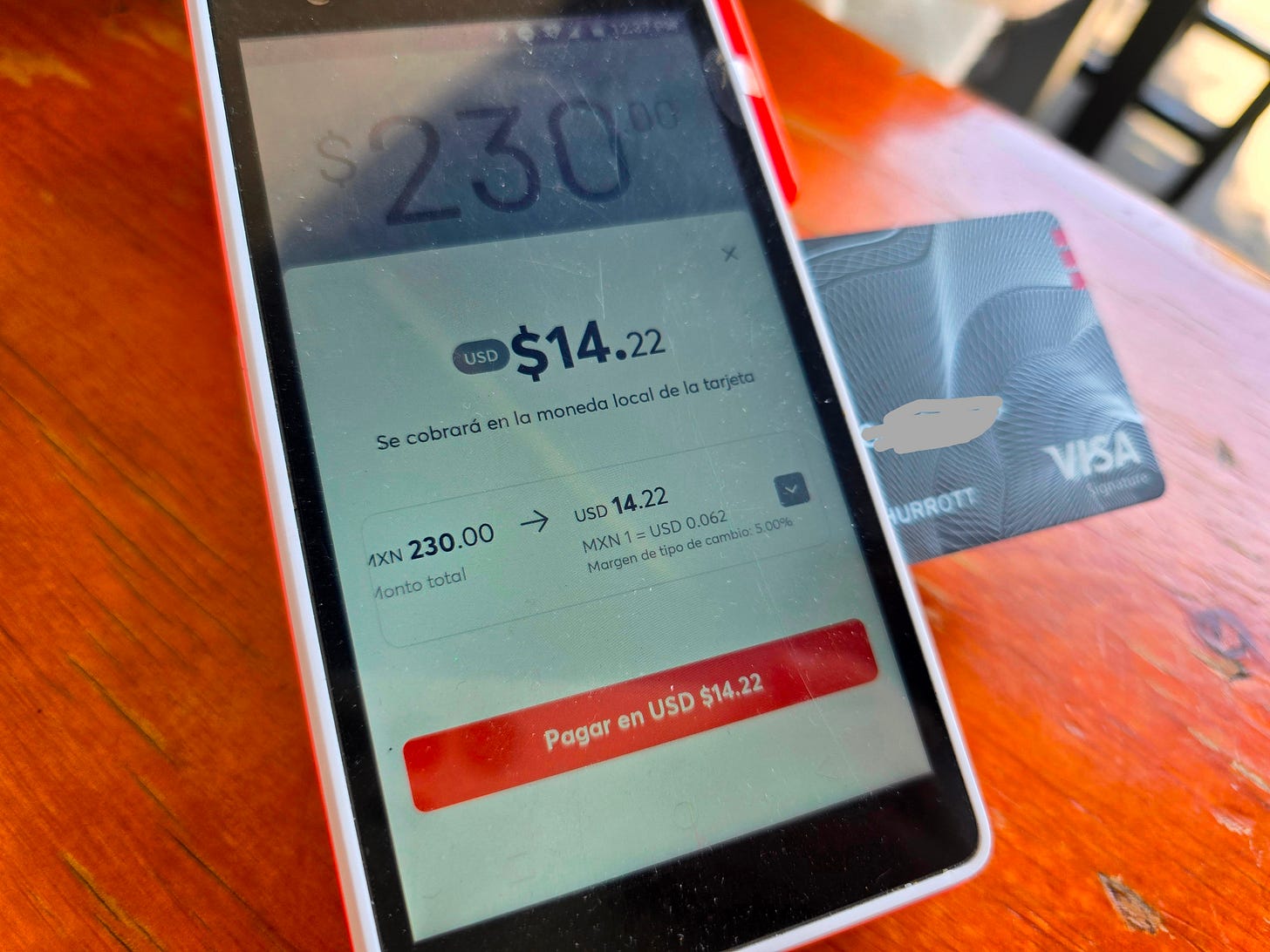
Here in Mexico, when you want to pay for something with an American credit card, you almost always have the option to pay in either Mexican pesos or US dollars, like you can see in the photo above. Sometimes the US dollar option is more prominent, and the Mexican pesos option is smaller, at the bottom.
The server or clerk might pick the currency for you, and you might not even realize there’s a choice. That’s OK if the person knows what they’re doing. But sometimes that’s not the case, and the wrong choice can cost you.
We have a friend here who owns a restaurant, and he always picks pesos for his customers, regardless of their home currency, because he knows that’s the better exchange rate.
If you have the option to make the choice yourself, when you’re looking at the payment screen, you’ll see the amount you would pay in both pesos and dollars.
Always choose pesos. Here’s why.
You will almost always get a better exchange rate from the bank where you have the credit card.
Plus, when you choose dollars, you’re agreeing to something called a “margin.” In the example above, the margin is 3%, but it could be from 2 to 5%, depending on the bank that’s processing the transaction. That’s a surcharge you pay in addition to the exchange rate. Paying an extra 2 to 5% adds up over the course of a trip, especially when you use credit cards for bigger purchases like hotels and upscale meals.
The bottom line: When you allow a bank or credit card processor to convert your payment between currencies, you pay more. Sometimes, a lot more. Always choose pesos.





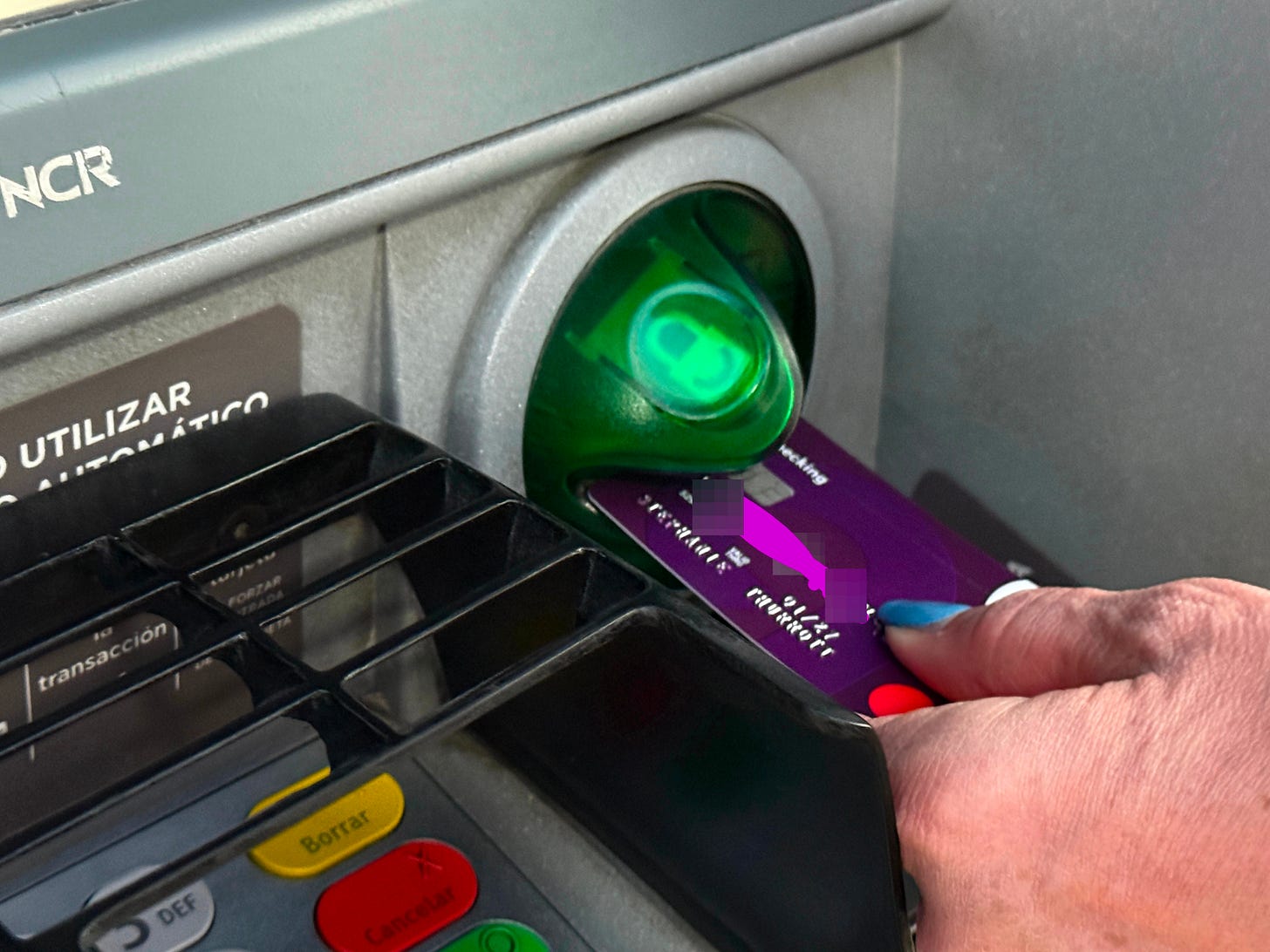
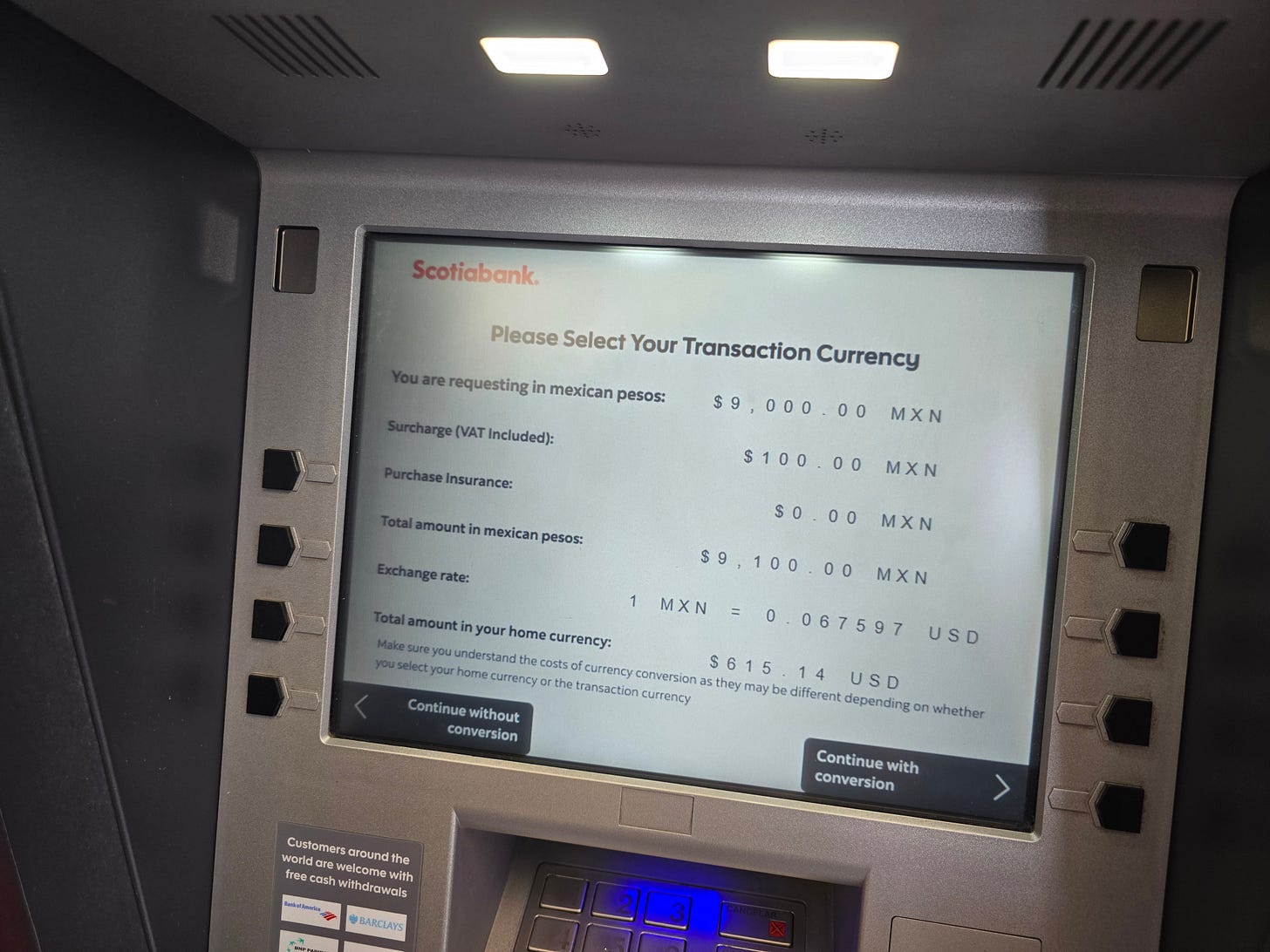


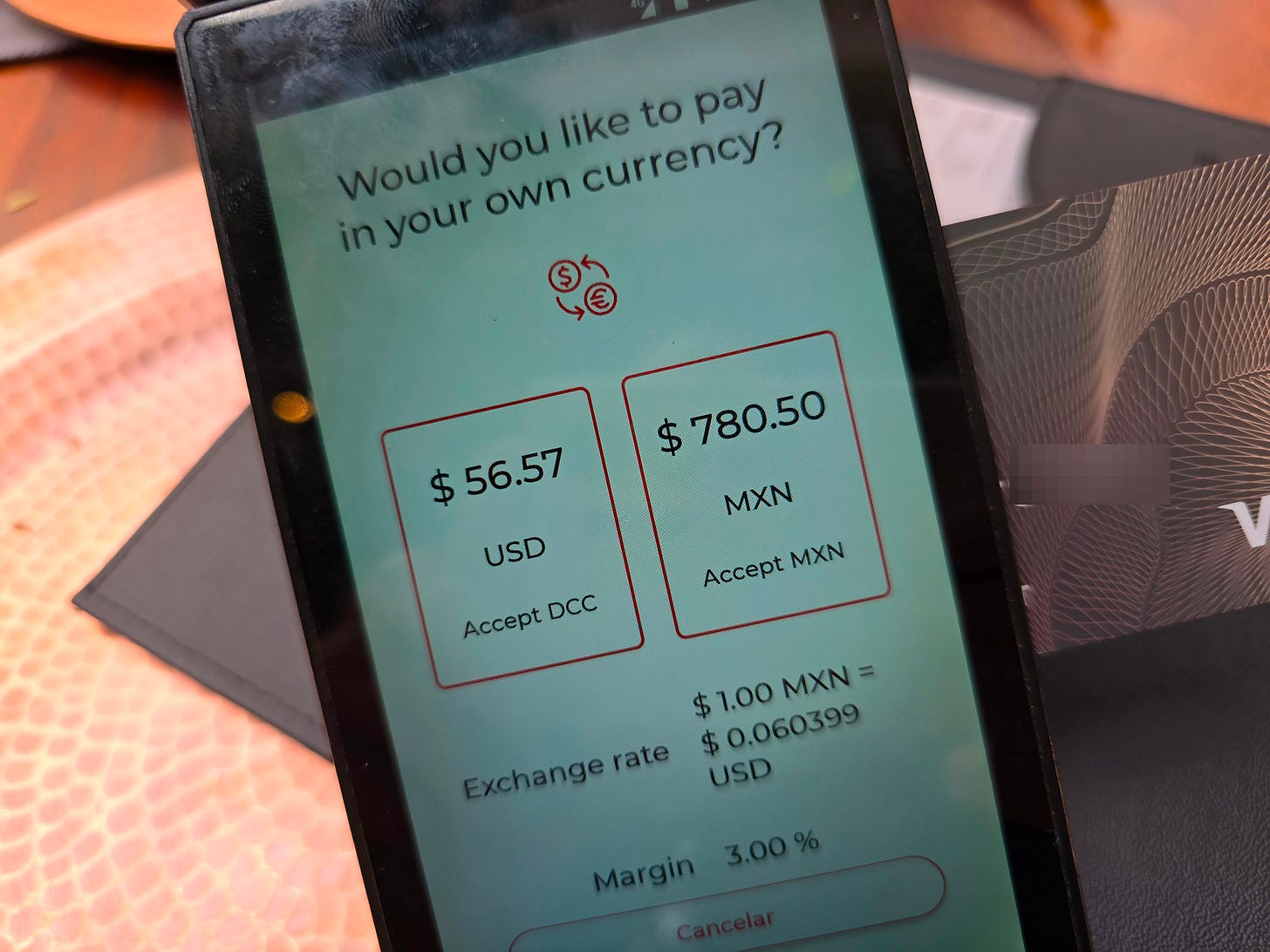
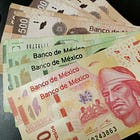
Thanks! It's a mini-obsession of mine :) I will often mention to servers how it's always better for people to pay in the local currency to try to spread the word.
Excellent tutorial on ins and outs of ATMs and credit cards vs cash et al.